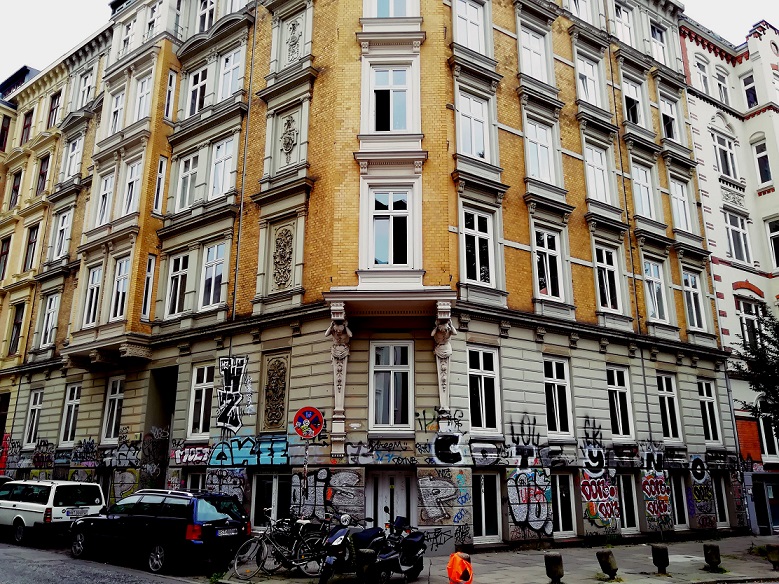The most important news at one glance – Our press review of the calendar week 36. From Hip-Hop for the Favelas of Rio de Janeiro into the heart of Perpignan. About Tokyo’s planned highest skyscraper up to London’s attempt to eliminate their disadvantages for pedestrians. Our summary of the most important urban news.
City and human
In the heart of Perpignan – Community of Sinti and Roma threatened with expulsion
The soul of the French city of Perpignan is deeply rooted in the existence of a large gypsy community, the travelling people, who have found a refuge in the central historic district of Saint Jacques. Not far from the Spanish border, it is also one of the cities with the highest poverty rate in France. The article published by The Guardian, accompanied by photographs by Jesco Denzel, invites the reader to enter the world of the French “Gypsies” and at the same time takes a critical look at the renovation measures. The relationship of the gypsy community with the city can be dated back to several hundred years, 1940 being a decisive year. Restricted in their freedom of movement by the prohibition of “nomadism” under the Vichy regime, the gypsies were forced to settle in Perpignan. The St Jacques district, where 90% of young people are unemployed, is inhabited by three-quarters of people exposed to institutional discrimination throughout Europe.
Since the collapse of two houses in the district of Noailles in the french city of Marseille, which emphasize the problem of inferior buildings and inhumane shelters in France, the inhabitants of Saint Jacques have voiced a legitimate distrust of the correct course of the renovation work. The modernisation plans for the historic old town are scheduled for 2024 and lead to tensions. Justifiable doubts about the honesty of the proposals face the fears of expulsion and loss of their community. In the Saint Jacques district, 483 buildings will be demolished to make room for 240 new ones.
Urban development
Skyscraper race: Japan to soon have a new record holder
The highest building in the country will be built in Tokyo
At 361 yards high, the tallest of the three towers planned for the Toranomon-Azabudai project surpasses the current record holder, a skyscraper by Abeno Harukas in Osaka, by as much as 33 yards. According to an article on CNN, an entire district of more than 95679 square yards will be renovated and revitalized by 2023.
According to the developer Mori Building Co., the project consists of offices and apartments for 20,000 employees and 3,500 residents as well as shops, fitness studios, museums, an international school and 28704 square yards of greenery – a “modern urban village”.
The project was designed by Pelli Clarke Pelli Architects. Originally native to Argentina, Cesar Pelli built his reputation as a star architect with innovative skyscrapers after creating the Petronas Towers in Kuala Lumpur and the Paci Center in West Hollywood. Born in 1926, he died in July of this year, leaving behind more than four decades of creativity. Together with the co-founder of the architectural firm, Fred Clarke, he was instrumental in designing the facades of the three towers.
Singapore architect Soo K. Chan, who participated in the project, said in a telephone interview that he emphasized details and craft, both traditional values of Japanese culture. Also, the interiors of the residences are based on ideas such as that the houses are planned around service areas such as kitchens – views and a certain kind of expected lifestyle in Japan are taken into account.
While London contemplates new skyscraper designs….
This month, the City of London Corporation, which governs the Square Mile with the financial district, issued the UK’s first “wind microclimate guidelines”. These aim to encourage walking and cycling by reducing the effects of wind on the ground – because wind tunnels and downdrafts on and around skyscrapers can make life difficult for people at ground level, reports wired.com. The engineering firm, which was involved in the development of the new standards, also cooperates with the major cities in North America. The City of London guidelines establish wind speeds for sitting and walking, wind tunnel tests and computer simulations to predict how a new building will meet these guidelines and where measurements should be made. For outdoor cafés and restaurants, where people sit frequently, 5.6 mph should not be exceeded. Studies carried out by the wind specialist-firm RWDI have modified the existing Lawson scale. It said that speeds between 18 and 20 mph are fine for “business walking” – the new scale calls more than 18 mph “unpleasant”.
Urban Culture
Berlin and Graffiti
The Berlin local newspaper Morgenpost reported on Tuesday (03.09.2019) in an article about the increasing “vandalism rate” in Berlin‘s public transport system. The German capital is known for its flourishing graffiti scene, including a steady influx of scene tourists. Besides the countless graffiti in the neighbourhoods, the yellow subway cars are also very popular among the sprayers. The local traffic stands thereby in the center of the article and all the same whether regional or subway, the trains are generally in demand among the sprayers. The Internet contributes with social networks such as Instagram to the rising popularity. This leads to several “Wholecar” actions every year, in which the train is stopped during the day and a whole passenger car disappears under the paint of the spray cans within minutes. The Morgenpost reports that the Deutsche Bahn refunds thereby up to 3000 reports per year because of Graffiti. On average eight per day per year. Two thirds of the reports relate to trains while the other third relates to the area belonging to the stations. Urbanauth already reported on this in its article “BVG and Graffiti”. According to Jannes Schwentu, the spokesman for the Berlin public transport company, a painted train would inevitably be cancelled 24 hours. Especially in case of a complete repainting, when the protective films have worn out, it becomes expensive for the railway company.
Hip-Hop to the youth from the Favelas
The community reporting project Rio on watch accompanied the hip-hop dancer ZULU for their article Hip Hop in the Baixada. With his project Cypher na rua, he enables children and young people in the Mesorregião Baixada of Rio de Janeiro to learn hip-hop dancing. A Cypher describes the gathering of actors of the hip-hop scene to dance, make music or spray. The article focuses on the community-building advantages for young people.
This journalistically active NGO is the successor of Rio Olympics Neighboorhood Watch (2010-2016), which dealt with the impact of the Olympic Games in Rio de Janeiro, Brazil, on the lives of people in the favelas. From 2017, with the end of the Games, Rio on watch adapted its editorial guidelines. Life in the poor parts of the megalopolis continues to be at the forefront of their reporting.

